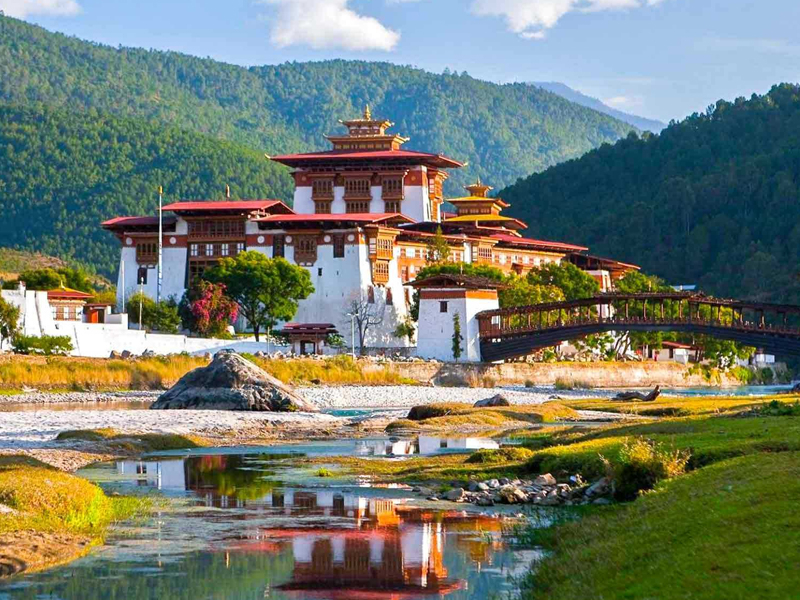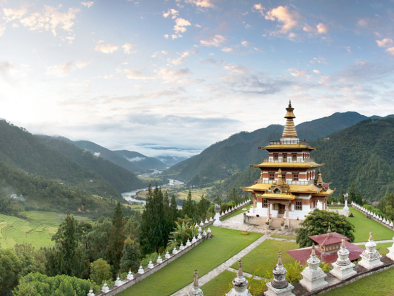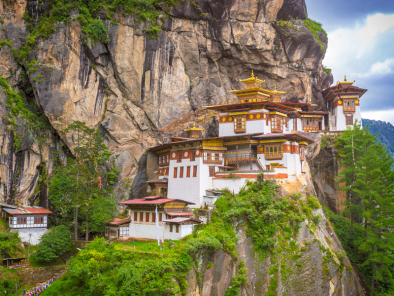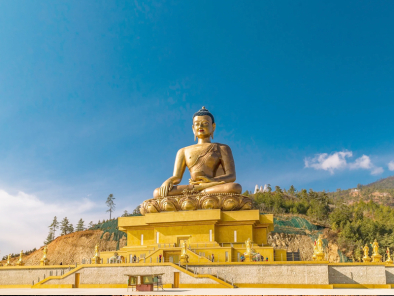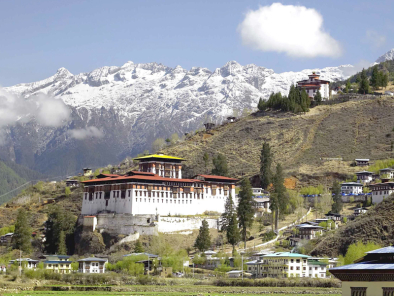The flight to Paro is one of the most spectacular in entire Himalayas. Flying along the Himalayan range from Kathmandu, the journey offers fascinating views and an exciting descent into the Kingdom. Bhutan’s first gift to you as you disembark from the aircraft will be cool, clean fresh and virgin mountain air. After immigration formalities and baggage collection, you will be met by our representative outside the exit gate, and afterwards drive to Thimphu, the capital town of Bhutan.
On arrival, in Thimphu check-into the hotel. The capital town of Bhutan and the centre of government, religion and commerce, Thimphu is a unique city with unusual mixture of modern development alongside ancient traditions. With the population of about 90,000 it is perhaps still the world’s only capital city without a traffic light.
Later in the day take an exploratory walk around Thimphu Craft Bazaar located a few minutes walk from down town hotels. This market offers genuine Bhutanese arts & crafts thus contributing in promotion, protection and preservation of traditional arts.
Overnight at the hotel in Thimphu.
-
-

- Dinner
Included
-

After breakfast, proceed for sightseeing tour of Thimpu, city’s main attractions that includes:
Royal Textile Museum (open between 09:00 am – 04:30 pm during summer and till 03:30 hrs. during winters, closed on weekends and govt. holidays): is worth a visit to get to know the living national art of weaving. Exhibitions introduce the major weaving techniques, styles of local dress and textiles made by women and men.
National Library (open between 09:00 am – 05:00 pm during summer and till 04:00 hrs. during winters, closed on weekends and govt. holidays): The history of Bhutan lies imprinted in archaic texts, which are preserved at the National Library. Besides thousands of manuscripts and ancient texts, the library also has modern academic books and printing blocks for prayer flags.
Institute for Zorig Chusum (open between 09:00 am – 05:00 pm during summer and till 04:00 hrs. during winters, closed on weekends and govt. holidays): Commonly known as Arts & Crafts School or Painting School, the Institute offers a six-year course on the 13 traditional arts and crafts of Bhutan. On a visit, one can see students learning the various skills taught at the school.
(Zorig Chusum is an art school and is periodically closed for exams, summer and winter holidays, if it is closed on your scheduled sightseeing day, we shall replace it with visit to Zangthopelri Lhakhang)
Zangthopelri Lhakhang: The present structure was built in 1960s and although lacking the charm of many of the older temples, Zangthoo pelri still possesses some impressive murals and art treasures and is worthy of a visit. The site of the temple was a former battle ground, and the temple was constructed there in order to pacify energies.
Simply Bhutan Museum: (open between 09:00 am – 05:00 pm) This privately owned museum depicts the ancient Bhutanese architecture which is being lost to modernization. The uniqueness of the structure is in its composition of the materials used. The structure is built reusing old timber, window and door frames and other items from traditional and old demolished houses. The best part is the portrayal of the age-old life styles of the Bhutanese people.
Lunch followed by city tour that includes:
Memorial Chorten (open between 09:00 am – 05:00 pm during summer and till 04:00 hrs. during winters): The stupa built in the memory of Bhutan's third King, His Late Majesty, King Jigme Dorji Wangchuk, who is popularly regarded as Father of modern Bhutan. The paintings and statues inside the monument provide a deep insight into Buddhist philosophy.
Buddha Point or Kuensel Phodrang (open between 09:00 am – 05:00 pm during summer and 09:00- 04:00 hrs. during winters): Located at a short drive from Thimphu city centre, visitors can get a good overview of the Thimphu valley from the Buddha point (Kuensel Phodrang). You can pay your obeisance and offer prayers to the Buddha, the largest statue in the country and then walk around and take a glimpse of the valley.
Changangkha Lhakhang: is one of the oldest monasteries in the Thimphu valley (open between 09:00 am – 1:00 pm and 2:00 pm - 4:00 pm during winters and 5:00 pm during summers). It was built in the 15th century by a descendant of Lama Phajo Drugom Zhipo, the man who spread the Sect Drukpa Kagyu in Bhutan. The main statue at the temple is of Avalokiteswara (the eleven-headed Buddha manifestation with 1000 arms and 1000 eyes). The temple courtyard offers good views over the city of Thimphu.
Conclude the tour of the day with a visit of Trashichhoedzong (open on weekdays after 05:30 pm during summer and after 04:30 pm during winter and during weekends between 09:00 am - 05:00 pm during summer and 09:00 am - 04:00 pm during winter) , “fortress of the glorious religion”. This is the center of government and religion, site of monarch’s throne room and seat of Je Khenpo or Chief Abbot. Built in 1641 by the political and religious unifier of Bhutan, Shabdrung Ngawang Namgyal, it was reconstructed in 1960s in traditional Bhutanese manner, without nails or architectural plans.
-
-

- Breakfast
Included
-
-

- Dinner
Included

After breakfast, proceed for sightseeing tour of Thimpu, today’s main attractions include:
Jungshi Handmade Paper Factory (open between 09:00 am – 05:00 pm during summer and till 04:00 hrs. during winters, closed on weekends and govt. holidays): is one km drive from city. It manufactures traditional Bhutanese paper using the bark of two tree species - the Daphne tree and Dhekap. The entire process of traditional manufacturing of the handmade paper can be observed here.
Takin Preserve Zoo (open between 09:00 am – 04:00 pm, closed on Monday): is one of the few places in Bhutan where we can see Takin, the national animal of Bhutan and a unique combination of Goat and an Antelope.
Folk Heritage Museum (open between 09:00 am – 05:00 pm, closed on Sunday and govt. holidays): is a traditional house replicating a farmhouse giving an insight to the Bhutanese lifestyle, and artifacts from the rural households. The museum also organizes regular demonstrations of rural traditions, skills, habits and customs as well as hosting educational programs for children. The house design and many of the artifacts are also reminders of rural Bhutanese life.
Royal Botanical Park (open between 09:00 am – 05:00 pm during summer and till 04:00 hrs. during winters, closed on govt. holidays): it occupies an area of nearly hundred twenty km square and forms the backdrop of the Dochula Pass. It was inaugurated on the centenary of the monarchical rule in Bhutan.
This is a paradise for nature lovers and is famous for its rhododendrons beside over a hundred different varieties of ferns. It is also home to several rare animals and birds like the red panda, musk deer and the blood pheasants.
Bhutan Post Office Museum (open between 09:00 am – 05:00 pm during summer and till 04:00 hrs. during winters, closed on govt. holidays): While you are in Bhutan, you must visit Bhutan Post office to get your own customized stamps made which can be used to post letters from Bhutan to anywhere in the world.
Weekend Market – (only from Friday to Sunday) is one of the most happening market which attracts lots of tourists, here locals from nearby areas come and sell fruits, vegetable, spices and crafts.
Institute of Traditional Medicines (open between 09:00 am – 05:00 pm during summer and till 04:00 hrs. during winters on weekdays and between 09:00 am – 12:00 pm on Saturday, closed on Sunday and govt. holidays): established in 1978, iIt prepares and dispenses traditional herbal and other medicines. There is an impressive laboratory and production facility that manufactures quality products. All kinds of pills, tablets, ointments and medicinal teas from here are distributed to regional health-care units around the country.
-
-

- Breakfast
Included
-
-

- Dinner
Included

-
-

- Breakfast
Included
-
-

- Dinner
Included

After breakfast visit Sangchhen Dorji Lhuendrup Lhakhang nunnery: Perched on a ridge amid pine trees and overlooking valleys of Punakha and Wangduephodrang, gleams the magnificent structures of Sangchhen Dorji Lhuendrup Lhakhang (Temple). The temple houses a 14-foot main bronze statue of Avalokiteshvara (Chenrigzig chagtong chentong). Other statues include those of Guru Padmasambawa, Gautama Buddha, Zhabdrung Ngawang Namgyel, Tsela Namsum, the 21 Taras and Tsepamay (Buddha of longevity). The Avalokiteshvara statue, one of the biggest in the country, was the handiwork of entirely local Bhutanese artisans.
The temple complex also houses a permanent higher learning and meditation centre for nuns where, apart from religious trainings, it provides life skill training such as tailoring, embroidery, statue making and thangka painting.
Afternoon hike up through fields of chilies, cabbages to Khamsum Yuelley Namgyal Chorten, which was built to remove negative forces and promote peace, stability and harmony in the changing world. The Chorten dominates the upper Punakha Valley with commanding views across the Mo Chhu and up towards the mountainous peaks of Gasa and beyond a stunning monument recently built by the Queens and consecrated in 1999.
Overnight at the hotel in Punakha.
-
-

- Breakfast
Included
-
-

- Dinner
Included

-
-

- Breakfast
Included
-
-

- Dinner
Included

After breakfast excursion to Taktshang Monastery (5 hrs hike, open between 09:00 am – 05:00 pm): It is one of the most famous of Bhutan’s monasteries, perched on the side of a cliff 900m above the Paro valley floor. It is said that Guru Rinpoche arrived here on the back of a tigress and meditated at this monastery and hence it is called ‘Tiger’s Nest’. This site has been recognized as a most sacred place and visited by Shabdrung Ngawang Namgyal in 1646 and now visited by all Bhutanese at least once in their lifetime. On 19 April, 1998, a fire severely damaged the main structure of building but now this Bhutanese jewel has been restored to its original splendor.
On the way back to town stop at Drukgyel Dzong, a fortress where Bhutanese warriors fought Tibetan invaders centuries ago. The snowy dome of sacred Chomolhari, "mountain of goddess'' can be seen in all her glory from the approach road to the Dzong.
Along the way, visit the 7th century Kyichu Lhakhang (open between 09:00 am – 05:00 pm during summer and till 04:00 hrs. during winters): is one of the 108 temples built in the Himalayas by Tibetan King, Songtsen Gampo. The building of this temple marks the introduction of Buddhism in Bhutan.
OR – Chele la driving excursion
After breakfast at hotel, drive to Chele la (mountain pass), at an elevation 3,988 meters, considered to be one of the highest motorable passes in Bhutan. About an hour's drive along a thickly-forested road, is this botanical paradise located. The pass provides stunning views of the sacred mountain Jomolhari and Jichu Drake. It is also marked by hundreds of prayer flags fluttering in the wind. Here, visitors can see cascades of wild roses; purple and yellow primulas; and swathes of deep blue iris covering the forest floor. The top of the pass bloom with rhododendrons in a variety of colours-pale pink, deep pink, burnt orange, mauve, white and scarlet.
Later in the day drive back to town. Evening an exploratory walk around main street and market area.
Overnight at the hotel in Paro.
-
-

- Breakfast
Included
-
-

- Dinner
Included
After breakfast, drive to the airport for flight to your onward destination. Our representative will see you off and then bid you farewell.
-
-

- Breakfast
Included
-
Inclusions International
- GST 5% on Total Cost of Package
- 5% TCS (Tax Collection at Source) is applicable for all payments from 1st Oct, 2020, applicable on total invoice value
- City Tax Payable Directly at Hotel At the Time of Checkout
- Visa Fee
- Air Ticket
- Medical / Travel Insurance
- Super peak season surcharge in hotels or weekends surcharges(if any)
- Any item of personal nature viz telephone, beverages , laundry , tips gratuities etc
- Any other services that is not shown/ mentioned in the list of inclusion above
- Meals and sightseeing other than above
- For Air Tickets Support Services
- Presently most of the Airline need the Passenger to do the web Check in Before check in Air Airport , Passenger Can Do the Web Check in at Own Level at Airline Web Site and Take the Boarding Pass , Web Check in offer
- * Select the Seats Preferred ( Some Seats Attract Charges Payable to Airlines )
- * Meals Preferred ( If No Meal is Booked Advance Preferred Meals Cannot be Guaranteed)
- * Print Boarding Passes
- Regency Tours offer Services (other Actual Charges Payable Extra )
- Web Check In Domestic Rs 200 Per Person Per Sector
- International Rs 300 Per Person Per Sector
- Meals Meals Cost As per Airline if Any ( No Extra Charges)
- International Travelling Air Suvidha Rs 500 Per Person
- Travel Pass Rs 500 Per Person Per Country
- RT PCR/Covid Test Support fee Rs 500 Per Person Per Country
- Medical / Travel Insurance As Per Actual Cost of Policy
- Ticket Reissue/refund Domestic Rs 300 Per Sector
- International Rs 500 Per Sector
- Guests if Not Vaccinated :-need to carry a Covid-19 RT-PCR negative test report sample given within 96 hrs of arrival dat
- Kindly carry few copies of your Covid Report and Photo ID for convenience
- The above is only a quotation and we are not holding any confirmed reservation/services at the moment.
- The above quote is valid for a period of 3 days starting today.
- Any amendments in the dates of travel or number of passengers will attract a re-quote.
- Prices are subject to change unless booked and paid for in advance.
- Rates for arrival and departure transfers and coach tours are based on all passengers travelling together in one vehicle with all passengers arriving/departing together (in the same flight). Airport transfer rates are not valid in case passengers are arriving / departing on different flights. Any change in Pax numbers will result in change in rates.
- Rooms will be subject to availability at the time of confirming the reservation.
- Kindly note that driver will wait at the arrivals for a maximum of 120 minutes after the flight arrives.
- PAN Card and Passport Copies are mandatory of all the Passengers.
- Prices are valid for stated travel period and are of defined validity, any change in the dates will lead to re-costing.
- For the above said tour, there is no pick up and drop off from the hotel (unless specified), so client will have to reach at departure points and back to hotel also at their own arrangement
- All train tickets are subject to price at the time of issuance. Price May fluctuate for train tickets, exact price to be considered at the time of issuance
- The Guests will have to manage on their own till the Pickup / Drop off point for SIC TOURS
- All above costs are quoted per person in Indian Rupees. In the event if there is any fluctuation of USD rate against Indian Rupees (INR) or any extreme changes of unforeseen economical fluctuation, we will have to re-quoted the prices accordingly
- All above rates are quoted and valid for min 03 pax. In any event the number of participant is less than that number, we have right to re-visit and re-quote accordingly.
- Price quoted based on lowest room category.
- The Hotel Standard Check In time 1400hrs and Check out time 1200hrs.
- Early check in will be considered as 01 night stay. Free early check in is based on request and availability.
- Late check-out is based on request and availability only.
- No room, flight booking has been blocked and no land arrangement has been made yet. Room confirmation & bedding type is subject to availability upon booking is made. if the same property is not available will advise you similar category, in case there is a variation in hotels / room category difference will be supplement.
- **Airport / Hotel / Station Transfers Between 2100hrs and 0500hrs will lead to Extra Night surcharges&hellipwhich has to be paid extra apart from above cost
- Above rates are Nett and Non-commissionable.
- All tours are subject to Regency Tours Pvt. Ltd tour conditions.
NOTE:
- No Cash Deposite if Allowed in Bank Account, Only Payment Modes are NEFT, RTGS, Chq,G Pay, Paytm, Credit Card ( Bank Charges Apply)
- As per Govt Norms 5% TCS will be Applicable for on Outward Remittance ( PAN Card Mandatory for All Outbound Bookings)
- As per RBI guidelines it is mandatory to provide Pan card of the traveller.
- Henceforth bookings will be processed only upon receipt of pan card photocopy
- Prices are valid for stated travel period and are of defined validity, any change in the dates will lead to re-costing.
- Any cancellation of rooms must be notified in writing 7 working days before group arrival and you must ensure you receive our acknowledgment in order to avoid cancellation charge imposed by hotel to you. Different cancellation deadlines may apply to public holidays, Christmas, New Year, Chinese New Year, individual hotel & peak periods, special events, fairs, conferences and convention periods.
- During individual hotels ,peak periods, special events, fairs, conferences and conventions, rooms held must be washed down according to the hotel policy. Otherwise unused rooms will be charged accordingly by hotel to you.
- Certain sightseeing and day tours may be subject to weather conditions or minimum number of pax before they operate and suppliers may cancel of postpone the date of the tour at short notice. Any changes shall be notified to you at the earliest opportunity.
- There is no refund for services not utilized. Extra note for private transfers services,
- Closer to date bookings will attract 100% cancellation.
- Guests if Not Vaccinated :-need to carry a Covid-19 RT-PCR negative test report sample given within 96 hrs of arrival date
- Kindly carry few copies of your Covid Report and Photo ID for convenience
- Regency Tours will not be resposible for any Information and Changes in th Covid Restriction Imposed by Any Govt / Authorities
- Prepare a day-to-day itinerary
- Check your passport expiry date
- Print your tickets and insurance
- Carry you photo ID proof and a copy
- Check-in online for your flight
- Buy an international SIM card or activate international roaming
- If you are going to drive in another country, get an international license.
- Mail yourself the soft copies of all important s.
- Prepare a list of emergency phone numbers and carry in your wallet.
- Research a bit about the Indian Embassy and its location in the country you are visiting in case you need it during a natural or man-made disaster.
- We have Weekend Packages as well as Honeymoon & Family Packages not only this we are provide value for money deals to our corporate for incentive movements You enjoy each place in an unrushed style desire, feel and have the time of your life because we always believe in providing you the best.
Refund Policy
